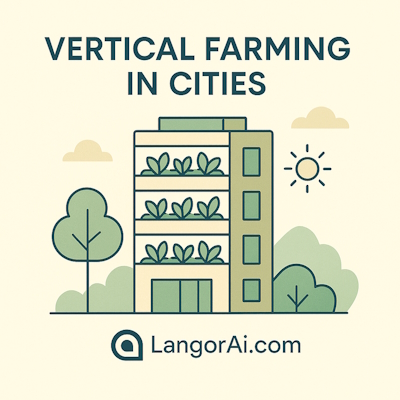
IELTS Reading Practice Test – Passage 1
The History and Development of Vertical Farming in Large Cities
For much of the twentieth century, city planners assumed that food would always arrive from outside the urban core. Farmland was horizontal by definition: a patchwork of flat fields connected to cities by highways, railways, and cold chains. Yet by the late 1990s, as megacities expanded and arable land per person shrank, architects and agronomists began to ask whether food production itself could move upward. The term “vertical farming”—the idea of growing crops in stacked layers inside controlled environments—entered mainstream discussion in the following decade, pushed along by concerns over food miles, pesticide use, and climate volatility.
Early visions were utopian and often impractical. Concept sketches showed glass towers filled with orchards and livestock, but these designs underestimated the energy required to light and ventilate tall structures. The first real breakthroughs occurred not in futuristic skyscrapers but in modest warehouses retrofitted with light-emitting diodes (LEDs). LEDs could be tuned to the red and blue wavelengths most useful for photosynthesis while consuming dramatically less electricity than previous lamps. Combined with hydroponics and aeroponics—systems that deliver nutrients in water or mist rather than soil— these lights enabled year-round cultivation with precise control over temperature, humidity, and nutrient concentration.
Demand-side pressures helped the model mature. Urban consumers increasingly expected salad greens with consistent taste and appearance at any time of year, while supermarkets wanted shorter, more reliable supply chains. Vertical farms located within or near cities reduced spoilage by harvesting on demand and could deliver produce within hours. During extreme weather events that disrupted highways or damaged fields, these facilities acted almost like backup generators for local food supply, stabilising prices for certain perishable crops.
The economics, however, have never been straightforward. Energy remains the dominant operating cost, and profitability depends on aligning crop selection with the technical realities of controlled environments. Leafy greens, herbs, and microgreens thrive because they grow quickly and fetch premium prices; staple crops such as wheat or rice have been largely excluded because they require more space, more light, and longer cycles. To improve margins, operators began to capture waste heat, negotiate off-peak electricity rates, and integrate rooftop solar where feasible. Some co-located with data centres, exchanging heat and carbon dioxide to improve photosynthetic efficiency.
Policy also mattered. Several cities created innovation districts that offered tax credits, low-interest loans, or expedited permitting for indoor agriculture. Food safety regulators developed standards for water quality and pathogen monitoring that resembled those of pharmaceutical clean rooms. While these rules increased compliance costs, they also reassured retailers and investors that vertically farmed produce could meet consistent benchmarks without relying on chemical pesticides.
By the mid-2010s, automation reduced labour intensity. Conveyor systems moved trays between germination, growth, and harvest zones; computer vision detected nutrient deficiencies; and machine-learning models adjusted lighting schedules to balance yield and power consumption. Despite these advances, some high-profile start-ups failed when expansion outran cash flow, revealing that scaling agriculture is not the same as scaling software. Profitable firms tended to grow deliberately, standardising a limited set of crops and replicating proven layouts rather than chasing eye-catching architecture.
The environmental ledger is complex. Vertical farms use far less water than field agriculture because hydroponic solutions are recirculated, and there is virtually no fertiliser runoff. They can also reclaim underutilised buildings and reduce transport distances. Yet the electricity footprint is significant. Where grids rely on fossil fuels, the climate advantage narrows; where renewable energy is abundant, the calculus improves. For this reason, the sector’s future is often tied to broader energy transitions—cheaper storage, smarter grids, and the decarbonisation of power generation.
Today, vertical farming is neither a cure-all nor a fad. It has settled into a pragmatic role: supplying high-value crops to dense markets with a premium on freshness and reliability. Future growth is likely to come from incremental gains—more efficient LEDs, better nutrient recipes, and hybrid models that combine indoor propagation with outdoor finishing. In short, cities are learning to grow up, but they are doing so one carefully measured layer at a time.
Questions 1–6: True / False / Not Given
Do the following statements agree with the information in the passage?
Write TRUE if the statement agrees with the information; FALSE if it contradicts the information; NOT GIVEN if there is no information.
Questions 7–10: Multiple Choice
Choose the correct letter, A, B, C, or D.
A) rising fertiliser prices
B) consumer expectations for year-round uniformity
C) agricultural export quotas
D) restaurant labour shortages
A) lack of interest from supermarkets
B) failure to automate harvesting
C) expanding faster than their finances allowed
D) unstable seed supply
A) buildings are shorter than six storeys
B) farms are located outside cities
C) electricity grids contain more renewable energy
D) only herbs are cultivated
A) diversify into livestock at scale
B) standardise a narrow crop range and repeat layouts
C) prioritise iconic architecture over process
D) avoid any form of automation
Questions 11–14: Sentence Completion
Complete the sentences below. Use NO MORE THAN TWO WORDS for each answer.
Answer Key & Explanations
1 → FALSE — Early designs underestimated energy for lighting/ventilation (para 2).
2 → TRUE — LEDs targeted red/blue wavelengths and cut electricity use (para 2).
3 → TRUE — City-near farms harvest on demand and deliver within hours, reducing spoilage (para 3).
4 → FALSE — Staples like wheat/rice are largely excluded due to space/light/time needs (para 4).
5 → TRUE — Co-location with data centres to exchange heat and CO₂ is explicitly stated (para 4).
6 → TRUE — Standards resemble pharmaceutical clean rooms (para 5).
7 → B — Year-round uniformity demanded by consumers/supermarkets drove adoption (para 3).
8 → C — Failures happened when expansion outpaced cash flow (para 6).
9 → C — Benefits improve with renewable-heavy grids (para 7).
10 → B — Profitable firms standardised a limited crop set and replicated proven layouts (para 6).
11 → soil — Hydroponics/aeroponics deliver nutrients without soil (para 2).
12 → off-peak — Operators negotiated off-peak electricity rates (para 4).
13 → stabilise — Facilities acted like backup supply, helping to stabilise local markets (para 3).
14 → incremental — Future growth via incremental gains (para 8).
